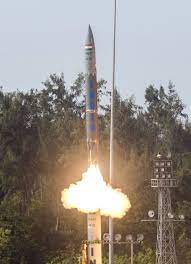Pralay Missile:

The Ministry of Defense has procured indigenous Short-Range Ballistic Surface-to-Surface (SRBM) Missile Pralay, giving Indian military the heft to its war-fighting capabilities.
- Pralay’ is India’s first conventional quasi-ballistic missile and is an answer to any conventional missile attack from northern or western borders.
- A quasi-ballistic missile has a low trajectory, and while it is largely ballistic, it can maneuver in flight.
- Ballistic missiles are initially powered by a rocket or series of rockets in stages, but then follow an unpowered trajectory that arches upwards before descending to reach its intended target at high speed.
- The missile has been developed in a way that it is able to defeat the interceptor missiles and also has the ability to change its path after covering a certain range mid-air.
- It is powered with a solid propellant rocket motor and many new technologies.
- The missile guidance system includes state-of-the-art navigation system and integrated avionics.
- It can be compared to China’s Dong Feng 12 and the Russian Iskander missile that has been used in the ongoing war with Ukraine.
- It is capable of carrying a conventional warhead of about 350 kg to 700 kg, which gives it a deadly punitive capability.
- It can carry a high explosive preformed fragmentation warhead, penetration-cum-blast (PCB) and runaway denial penetration submunition (RDPS).
- The missile has a range of 150-500 kilometre and can be launched from a mobile launcher.
- Pralay will be the longest-range surface-to-surface missile in the inventory of the Army.
- The Army also has the BrahMos supersonic cruise missile in its arsenal, with a stated range of 290-plus kilometres.




